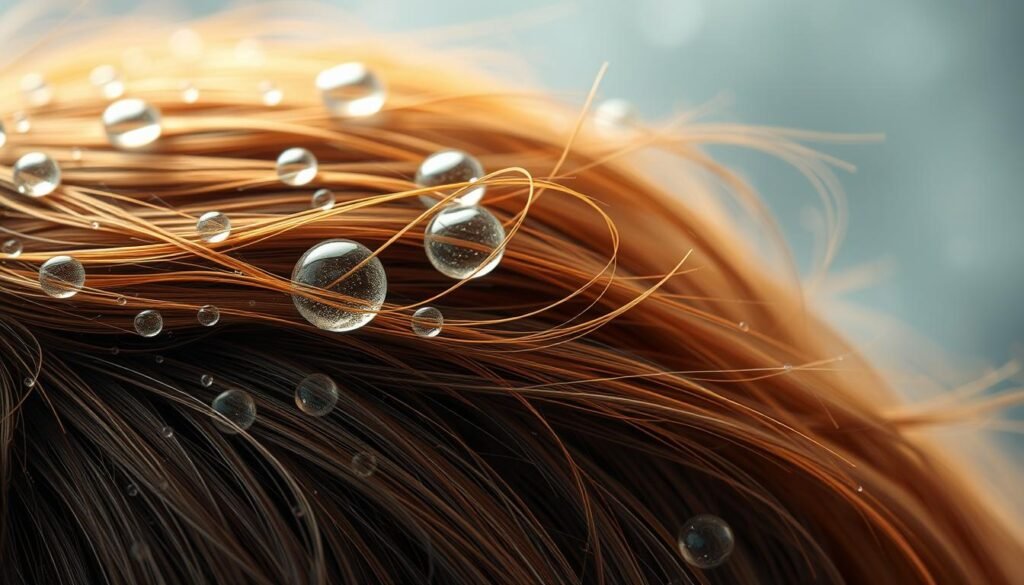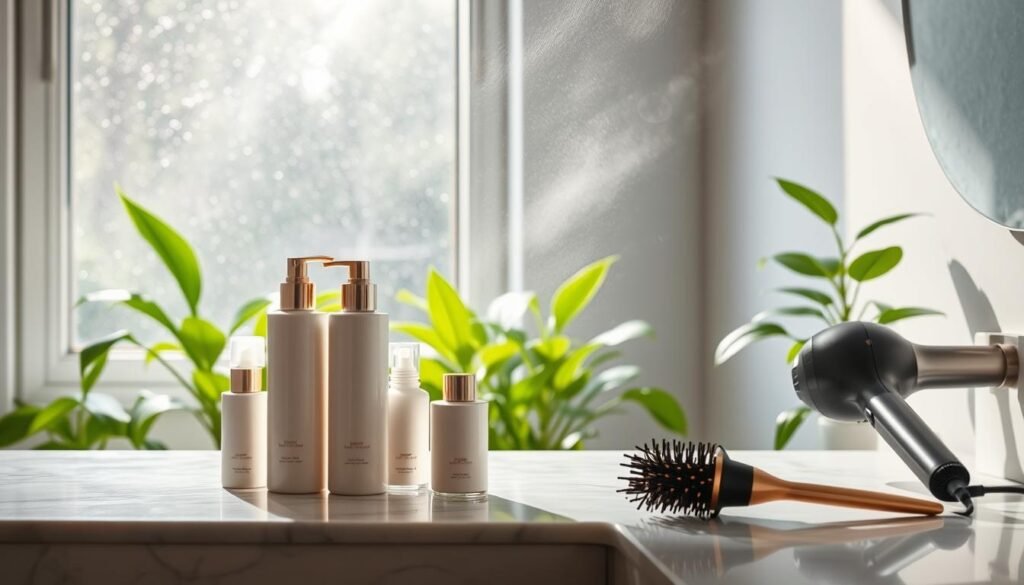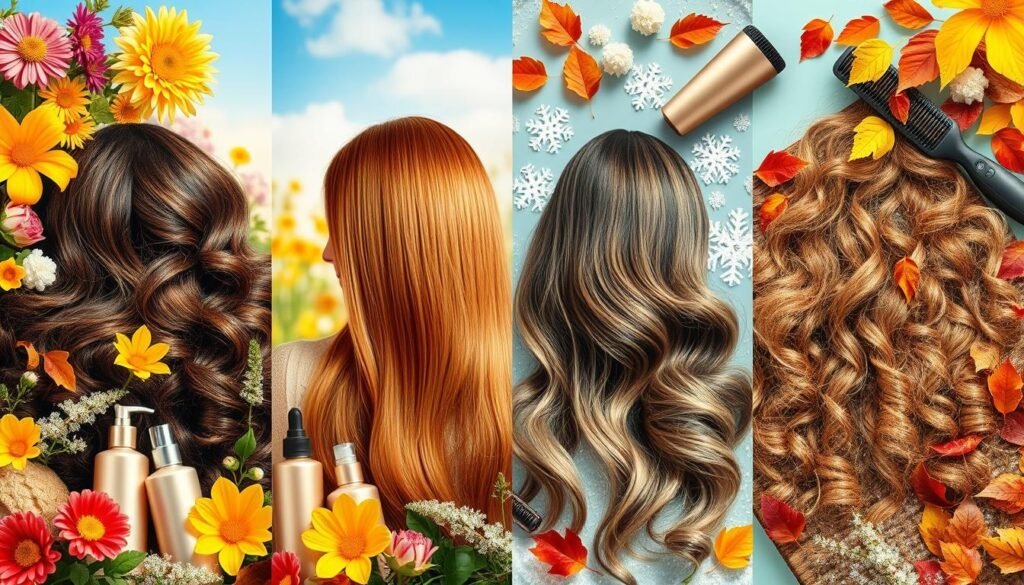How Does Humidity Affect Hair & How to Manage It
Did you know that humidity can significantly impact the health and appearance of your hair? A staggering 90% of individuals with curly hair report experiencing frizz and unruliness in humid conditions. The interaction between the moisture in the air and the proteins in your hair creates weak hydrogen bonds, leading to a wide range of hair-related issues.
Understanding how humidity affects different hair types is crucial for developing effective management strategies. While high porosity and curly hair are more prone to frizz, low porosity and fine hair can become weighed down and appear flat in high-humidity environments. Mastering the art of humidity control can transform your hair from a frizzy, unmanageable mess to a sleek, stylish masterpiece.
Key Takeaways
- Humidity significantly impacts hair health and appearance, leading to issues like frizz, flatness, and unruliness.
- Hair porosity and texture play a crucial role in how hair reacts to humidity, with curly and high porosity hair being more prone to frizz.
- Using the right hair products, techniques, and hairstyles can help manage hair in high-humidity conditions.
- Maintaining a balanced Hair Care routine focused on hydration is essential for combating the effects of humidity.
- Seeking professional help may be necessary for severe hair damage caused by long-term exposure to high humidity.
Understanding Humidity and Its Impact on Hair Health
Humidity, the amount of moisture present in the air, plays a crucial role in the health and appearance of our hair. Understanding the different types of humidity and how they interact with our tresses is essential for maintaining a healthy, manageable mane, regardless of the climate.
What Is Humidity?
Humidity refers to the concentration of water vapor in the air. It can be categorized into two main types: low humidity, which indicates dry air, and high humidity, which signifies moist, damp conditions. These contrasting levels of moisture can have a significant impact on our hair’s behavior and condition.
How Humidity Works
In low-humidity environments, hair tends to become dry, brittle, and prone to static buildup. The lack of moisture in the air causes the hair strands to lose their natural hydration, leading to a dull, frizzy appearance. Conversely, high-humidity conditions can cause hair to swell, resulting in unmanageable frizz and a loss of volume.
Different Types of Humidity
- Absolute Humidity: The actual amount of water vapor present in the air, measured in grams per cubic meter.
- Relative Humidity: The ratio of the amount of water vapor in the air compared to the maximum amount the air can hold at a given temperature, expressed as a percentage.
- Dew Point: The temperature at which the air becomes saturated with water vapor, indicating the likelihood of precipitation.
Understanding these different humidity measurements can help you anticipate and address the unique challenges your hair may face in various climate conditions, ensuring you can manage humidity and maintain healthy, beautiful locks.

The Science Behind Hair and Humidity
When it comes to understanding how humidity affects hair, it’s essential to delve into the science behind hair structure and its interaction with moisture. The intricate composition of hair, comprising the cuticle, cortex, and medulla, plays a crucial role in how it reacts to the varying levels of humidity in the air.
Hair Structure Overview
Hair is a complex structure composed of three main layers: the cuticle, the cortex, and the medulla. The cuticle acts as the outermost protective layer, while the cortex contains the majority of the hair’s protein, keratin. The medulla, the innermost layer, is often absent in finer hair strands.
The key to how humidity affects hair lies in the behavior of these layers, particularly the cuticle and the cortex. The cuticle’s raised scales can readily absorb moisture from the humid air, leading to swelling and changes in the hair’s shape and texture.
The Role of Water in Hair
Water molecules in the air can penetrate the hair shaft, causing the hair to swell and alter its shape. The level of porosity, or the hair’s ability to absorb and retain moisture, significantly influences how it responds to humid conditions.
- High porosity hair and curly hair are more prone to frizz and dryness in humid weather due to their raised cuticles that readily absorb moisture.
- Fine hair, on the other hand, tends to fall flat in humidity as it doesn’t absorb moisture easily, leading to flatness and limpness.
Understanding the science behind hair structure and the role of water in hair is crucial for effectively managing hair in humid conditions. By addressing the specific needs of different hair types, individuals can better combat the common problems caused by humidity and maintain healthy, manageable locks.

How Humidity Affects Different Hair Types
Navigating the challenges of humidity can be tricky, especially when it comes to maintaining the health and appearance of our hair. Understanding how humidity impacts various hair types is the key to developing effective strategies for managing this environmental factor.
Straight Hair
Straight hair often struggles with the effects of humidity. The lightweight strands readily absorb moisture from the air, causing them to become limp, lifeless, and lacking in volume. Humid conditions can make straight hair appear flat and greasy, as the extra moisture disrupts the hair’s natural oil balance.
Curly Hair
Curly hair textures are particularly vulnerable to the negative impacts of humidity. The porous nature of curly hair means it readily absorbs moisture, leading to frizz, unruly flyaways, and a loss of definition in curl patterns. Humidity can also contribute to hygral fatigue, a condition where the hair becomes weakened and damaged due to repeated cycles of absorption and evaporation.
Wavy Hair
Wavy hair often experiences a combination of the effects seen in straight and curly hair types. Humidity can cause wavy hair to become frizzier, while also potentially leading to a loss of body and shape. Maintaining the desired wave pattern can be a challenge in high-humidity environments.
| Hair Type | Humidity’s Impact | Ideal Solutions |
|---|---|---|
| Straight Hair | Limp, flat, and lacking volume | Volumizing products, humidity-blocking sprays |
| Curly Hair | Frizzy, unruly, and loss of curl definition | Moisturizing products, anti-humidity serums |
| Wavy Hair | Frizzy, loss of wave pattern | Flexible-hold styling products, humidity-resistant sprays |
Ultimately, managing humidity’s impact on hair requires a tailored approach based on individual hair type and porosity. By understanding the unique challenges faced by each hair texture, you can develop a personalized hair care routine to combat the adverse effects of humidity and maintain healthy, beautiful hair.

Common Problems Caused by Humidity
Humidity can be a real challenge for our hair, causing a range of frustrating issues. From frizzy, unruly locks to limp, lifeless strands, the effects of humidity on hair can be quite significant.
Frizz and Flyaways
One of the most notorious hair problems associated with humidity is frizz and flyaways. Curly and high-porosity hair types are particularly susceptible to this, as their hair strands tend to absorb moisture more easily. This can lead to rough, lifted cuticles and a halo of unruly frizz around the head.
Limpness and Loss of Volume
On the other hand, fine or straight hair can also suffer in humid conditions. Instead of frizz, these hair types may experience limpness and a loss of volume. The absorbed moisture can weigh down the strands, causing them to fall flat and appear lifeless.
Dryness and Damage
Surprisingly, humidity can also lead to dryness and damage over time, particularly through a process called hygral fatigue. This occurs when hair shafts repeatedly swell and shrink due to moisture absorption, which can eventually cause breakage and split ends.
Navigating the challenges of humidity and its impact on hair can be a real test of patience and hair care expertise. But with the right knowledge and strategies, you can learn to tame frizzy hair, boost volume, and protect your locks from the detrimental effects of moisture.

“Humidity is the enemy of straight, sleek hair, but it can also wreak havoc on curly and wavy textures. Understanding how to manage your hair type in humid conditions is key to maintaining healthy, beautiful locks.”
Signs Your Hair Is Affected by Humidity
Recognizing the signs of humidity-affected hair is crucial. Visual indicators include frizz, lack of shine, and changes in hair shape. Texture changes may manifest as roughness or a “sticky” feel. Styling challenges often arise, with hairstyles falling flat or becoming unruly quickly. Being aware of these signs helps in taking proactive measures to protect hair from humidity.
Visual Indicators
- Increased frizz and flyaways
- Dull, lackluster appearance
- Altered hair shape and volume
Texture Changes
- Rough, coarse feel to the hair
- Sticky or “wet” texture
- Swelling or puffiness of the hair strands
Styling Challenges
- Hairstyles falling flat or becoming unmanageable
- Difficulty achieving smooth, sleek styles
- Reduced longevity of hairstyles
Recognizing these signs can help you take the necessary steps to manage humidity’s impact on your hair and maintain a healthy, stylish appearance, even in challenging weather conditions.

| Hair Type | Humidity Impact | Recommended Solutions |
|---|---|---|
| Straight | Increased frizz and loss of volume | Use volumizing products and style with a blow-dryer on a lower heat setting |
| Curly | Excessive frizz and dryness | Apply moisturizing oils and serums to lock in hydration and minimize frizz |
| Wavy | Uneven wave pattern and increased dryness | Incorporate deep conditioning treatments and use a diffuser when styling |
By understanding the visual, textural, and styling challenges associated with humidity-affected hair, you can take proactive steps to manage the impact and maintain healthy, stylish locks, even in the face of high humidity.
Tools and Products for Managing Humidity
Living in a high-humidity environment can be a constant battle for hair health and styling. However, with the right tools and products, you can effectively manage the impact of humidity on your locks. From anti-humidity hair products to essential hair tools and natural remedies, there are various solutions to combat frizz and maintain a polished look.
Anti-Humidity Hair Products
To create a protective barrier against moisture, invest in hair serums, creams, and sprays designed specifically for humid conditions. These hair products can help lock in moisture, smooth the cuticle, and prevent frizz and flyaways. Look for ingredients like silicones, polymers, and humectants that can create a humidity-resistant shield for your hair.
Essential Hair Tools
Certain hair tools can make a significant difference in managing humidity-related hair problems. Opt for an ionic hair dryer, which uses negative ions to dry hair quickly and reduce static. Additionally, silk pillowcases can minimize friction and help maintain hairstyles in humid weather. Incorporating these tools into your routine can be a game-changer for managing humidity and hair.
Natural Remedies
For a more holistic approach, consider using natural ingredients to nourish and Protect your hair. Aloe vera gel can provide hydration and create a barrier against moisture, while coconut oil can help seal in moisture and prevent frizz. Applying these natural remedies to your hair can offer an extra layer of defense against humidity-induced hair woes.
By leveraging a combination of anti-humidity hair products, essential hair tools, and natural remedies, you can effectively manage the challenges posed by humidity and maintain healthy, frizz-free hair. Experiment with different solutions to find The Best approach for your hair type and needs.

Practical Tips to Combat Humidity
Navigating the challenges of humid weather can be a true test for your hair. However, with the right techniques and products, you can manage humidity and keep your locks looking their best. Let’s dive into some practical tips to combat the effects of humidity on your hair.
Pre-Styling Techniques
Before you even start styling, setting the stage for success is crucial. Begin by using a leave-in conditioner or a hair serum to provide a protective barrier against moisture. These products can help seal in hydration and prevent your hair from absorbing excess humidity. Additionally, applying a heat protectant before using hot styling tools can further shield your strands from the damaging effects of high humidity.
Protective Hairstyles
When the weather is humid, embracing protective hairstyles can be a game-changer. Styles like braids, buns, and sleek ponytails can help minimize your hair’s exposure to the humid air, reducing the risk of frizz and flyaways. These hairstyles also distribute moisture more evenly throughout your tresses, ensuring a polished and manageable look.
Technique for Your Hair Type
Understanding your hair type is crucial when it comes to managing humidity. For instance, if you have curly or wavy hair, diffusing your locks with a diffuser attachment can help enhance your natural texture and prevent frizz. On the other hand, if you have fine or straight hair, using cooler air settings on your styling tools can help prevent your strands from becoming limp and lifeless in the humidity.
By incorporating these practical tips into your hair care routine, you can confidently tackle the challenges posed by humid weather and maintain healthy, frizz-free hair. Remember, with the right hair Care Tips for humid weather, you can manage the effects of how does humidity affect hair and how to manage it effectively.

The Role of Hair Care Routine in Humidity Management
Maintaining a well-designed hair care routine is crucial for managing the effects of humidity on your locks. Proper hydration is the key to keeping your hair healthy and less susceptible to the moisture-laden air. By ensuring your hair is well-moisturized, you can prevent it from absorbing excess humidity and becoming frizzy.
Importance of Hydration
Staying adequately hydrated is essential for managing humidity’s impact on your hair. Well-moisturized hair is less likely to absorb excess moisture from the air, which can lead to unwanted frizz and loss of control. Regularly using hydrating shampoos, conditioners, and leave-in treatments can help lock in moisture and fortify your hair’s natural defenses against humidity.
Conditioning Strategies
Conditioning is a vital step in your hair care routine for combating humidity. Focusing on products and techniques that help seal the hair cuticle can be particularly effective in preventing frizz. Serums, oils, and deep conditioning masks containing ingredients like Argan Oil, Coconut Oil, and Shea Butter can help create a protective barrier against moisture absorption.
Frequency of Washing
The frequency of washing your hair may need to be adjusted based on humidity levels and your individual hair needs. Overwashing can strip away essential oils and leave hair vulnerable to humidity, while not washing often enough can lead to product buildup and greasiness. Finding the right balance is key to maintaining optimal moisture balance and managing frizz.
| Hair Type | Humidity Management Tips |
|---|---|
| Straight Hair | Avoid over-washing, use hydrating products, and consider anti-frizz serums or oils. |
| Curly Hair | Co-washing, applying leave-in conditioner, and using microfiber towels can help combat frizz. |
| Wavy Hair | Experiment with anti-frizz products, protective hairstyles, and reducing heat styling to manage humidity. |

Remember, a well-rounded hair care routine that addresses hydration, conditioning, and washing frequency can be a powerful tool in your arsenal for managing the effects of humidity on your hair. By understanding your hair’s unique needs and incorporating the right strategies, you can achieve frizz-free, healthy locks, even in the most humid conditions.
Seasonal Changes and Their Effects on Hair
As the seasons shift, our hair faces varying humidity challenges. From the heat and moisture of summer to the dryness of Winter, adapting our hair care routines is essential for maintaining healthy, vibrant locks year-round.
Summer Challenges
Summertime often brings high humidity, which can lead to unwanted frizz and flyaways. To combat this, it’s important to use lightweight, anti-humidity products that help control and smooth the hair. Additionally, protecting your hair from the sun’s UV rays is crucial, as excessive exposure can cause dryness and damage.
Winter Humidity Management
While winter is generally a drier season, indoor heating systems can create a surprising amount of humidity, which can also impact hair health. During the colder months, switching to more moisturizing products, such as deep conditioning treatments, can help replenish and nourish the hair, preventing it from becoming brittle and prone to breakage.
Adapting your hair care routine to the changing seasons is key to maintaining healthy, manageable hair. By adjusting your product selection and techniques, you can ensure your hair looks and feels its best, regardless of the humidity levels outside.

When to Seek Professional Help
While managing humidity-related hair issues can often be tackled with the right hair care routine and products, there are times when seeking professional help is necessary. Recognizing the signs of severe hair damage, such as excessive breakage or significant changes in hair texture, is crucial in determining when to consult a hair specialist.
Recognizing Severe Hair Damage
If you notice an increase in hair fall, brittle strands, or your hair’s texture has changed dramatically due to the effects of humidity, it may be time to seek professional assistance. Excessive frizz, limpness, or an inability to style your hair despite your best efforts could also be indicators of more serious hair damage that requires expert intervention.
Consulting with a Hair Specialist
A hair specialist, such as a trichologist or a licensed cosmetologist, can provide personalized advice and treatments tailored to your specific hair type and humidity challenges. They can assess the extent of the damage and recommend professional-grade hair treatments, such as keratin treatments or deep conditioning services, to help restore your hair’s strength and resilience against humidity.
By addressing severe hair damage caused by humidity, a hair specialist can help you regain control over your hair’s appearance and health, allowing you to confidently navigate the challenges of managing hair in humid weather conditions.

“Seeking professional help is crucial when your hair has suffered significant damage from humidity. A hair specialist can provide the expertise and treatments needed to restore your hair’s health and resilience.”
Conclusion: Mastering Humidity Management
Mastering humidity management for healthy hair is a multifaceted endeavor that requires understanding the science behind how humidity interacts with different hair types. By recognizing the unique challenges posed by both high and low humidity levels, you can develop targeted strategies to maintain optimal hair health and manage the adverse effects of moisture in the atmosphere.
Key Takeaways
The key to mastering humidity management lies in selecting the right hair care products, implementing proper hydration techniques, and adapting your routine to seasonal changes. Embracing the natural texture of your hair and avoiding excessive heat styling can also play a significant role in protecting your strands from the damaging effects of humidity.
Final Tips For Healthy Hair
To maintain healthy hair in humid conditions, incorporate regular trims to prevent split ends, minimize the use of heated styling tools, and opt for protective hairstyles when possible. Additionally, investing in high-quality, humidity-fighting products tailored to your hair type can be a game-changer in the battle against frizz, limpness, and dryness. By staying proactive and adapting your hair care regimen to the changing seasons, you can achieve resilient, radiant locks that thrive in any humidity level.
FAQ
What is humidity and how does it affect hair?
Humidity refers to the amount of moisture in the air. High humidity can cause frizz, flatness, and unruliness in hair, while low humidity can lead to dryness, brittleness, and static. The interaction between moisture in the air and hair proteins creates weak hydrogen bonds, leading to various hair issues.
How does hair structure and porosity influence how hair reacts to humidity?
Hair structure, including the cuticle, cortex, and medulla, interacts differently with moisture. Water molecules in humid air can penetrate the hair shaft, causing swelling and altering its shape. Hair porosity affects its ability to absorb and retain moisture, influencing how it responds to humidity.
How do different hair types react to humidity?
Straight hair may become limp and flat in high humidity, while curly hair is more prone to frizz and can become unmanageable. Wavy hair often experiences a combination of effects, potentially becoming frizzier or losing definition.
What are the common problems caused by humidity?
Humidity can cause frizz, flyaways, limpness, loss of volume, and even dryness and damage over time through a process called hygral fatigue, where hair repeatedly swells and shrinks due to moisture absorption.
How can you identify if your hair is affected by humidity?
Visual indicators include frizz, lack of shine, and changes in hair shape. Texture changes may manifest as roughness or a “sticky” feel. Styling challenges often arise, with hairstyles falling flat or becoming unruly quickly.
What tools and products can help manage hair in humid conditions?
Anti-humidity hair products like serums, creams, and sprays can create a barrier against moisture. Essential hair tools like ionic hair dryers and silk pillowcases can help reduce frizz. Natural remedies such as aloe vera gel or coconut oil can also provide additional protection and nourishment for hair.
What are some practical techniques for managing humidity-affected hair?
Pre-styling techniques include using leave-in conditioners and heat protectants. Protective hairstyles like braids, buns, and sleek ponytails can help minimize exposure to humid air. Adapting styling techniques to your specific hair type, such as diffusing for curly hair or using cooler air settings for fine hair, can significantly improve humidity resistance.
How can a well-designed hair care routine help manage humidity effects?
Proper hydration is key, as well-moisturized hair is less likely to absorb excess moisture from the air. Conditioning strategies should focus on sealing the hair cuticle to prevent frizz. The frequency of washing may need adjustment based on humidity levels and individual hair needs to maintain optimal moisture balance.
How do seasonal changes affect hair and humidity management?
Summer often brings high humidity, requiring extra frizz control and UV protection. Winter, while generally drier, can still present humidity challenges indoors due to heating systems. Adapting hair care routines seasonally, such as using lighter products in Summer and more moisturizing ones in winter, helps maintain hair health year-round.
When should you seek professional help for humidity-related hair issues?
Recognizing signs of severe damage, such as excessive breakage or significant texture changes, is important. Consulting with a hair specialist can provide personalized advice and treatments tailored to your specific hair type and humidity challenges. Professional treatments like keratin treatments or deep conditioning services can offer additional support.


